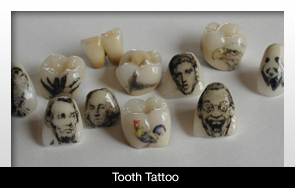 |
A tooth tattoo may be what dentistry needs to defeat tooth decay.
The tattoo, which was developed at Princeton University and Tufts University, contains a sensor that measures the bacteria levels in the mouth. The sensor is made of gold, graphite and silk.
After completing the bacteria measurement in the mouth, the sensors can determine when a patient is at risk for developing gum disease. The sensors may also have the ability to predict the risk for other diseases, which is a result of studying the data from the saliva. AIDS and stomach ulcers were two of the diseases the sensor was able to determine risk for.
The tooth tattoo does not have a complicated design. It’s made of a thin layer of gold, a layer of graphene and peptide, and a layer of silk to provide support for the structure. The silk layer was created to dissolve after the tattoo is pressed onto the surface of the tooth. After the sensors are placed, the tattoo is powered wirelessly.
The tooth tattoo hasn’t been tested on people yet, however, the trials on cow teeth have yielded promising results. The issue will be whether or not the tooth tattoo can be made thin enough to make certain the patient won’t deal with any type of discomfort. Cows won’t necessarily be bothered by the smallest of inconveniences in their mouth, whereas humans may be agitated with the device in their mouth.
More tests will be conducted to determine the feasibility of applying this technology to humans.


